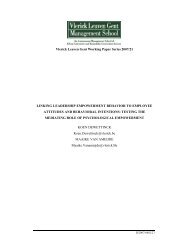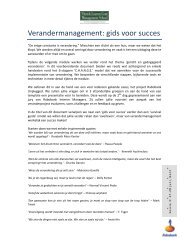Vlerick Leuven Gent Working Paper Series 2007/03 ... - Vlerick Public
Vlerick Leuven Gent Working Paper Series 2007/03 ... - Vlerick Public
Vlerick Leuven Gent Working Paper Series 2007/03 ... - Vlerick Public
You also want an ePaper? Increase the reach of your titles
YUMPU automatically turns print PDFs into web optimized ePapers that Google loves.
However, up to date the concept of diversity is a rather unexplored domain in<br />
empirical board research (Carter et. al., 2002). In contrast, research on diversity in other<br />
settings has a long-standing history. Although the issue of diversity has not been approached<br />
in a uniform way, two streams have been identified that influence the way diversity is<br />
conceptionalized. One stream of research approaches diversity from a moral-ethical<br />
perspective and focuses on the social inequity in order to identify discriminatory practices in<br />
the workplace. A second research stream studies diversity from an organizational and<br />
economical perspective in order to examine the effects of diversity on work-related outcomes<br />
(Janssens and Steyaert, 20<strong>03</strong>). Especially the latter points out robust relationships which can<br />
to some extent be extrapolated to the context of boards of directors.<br />
Diversity among board members is assumed to improve debate due to the obvious<br />
reason that diversity is commonly associated with different life experiences and hence diverse<br />
perspectives (Eisenhardt et.al., 1997). In fact, research on group heterogeneity suggests that<br />
creativity is positively related to skill-based heterogeneity because diverse perspectives can<br />
produce and consider a broad array of solutions and decision criteria (Schweiger et.al., 1986).<br />
This is of particular relevance when groups are confronted with complex, non-routine tasks, as<br />
it is the case with boards of directors. From a different point of view, research has also shown<br />
that board members who are in a minority position have the potential to provide unique<br />
perspectives and challenge the conventional wisdom among the majority in the board<br />
(Westphal and Milton, 2000). For example, when the majority of board members represents a<br />
particular functional background (e.g. finance), the opinion expressed by a board member<br />
with a different background (e.g. marketing) may shed another light on the topic, and hence,<br />
change the discussions.<br />
Although the results of empirical research on the cognitive capacity of groups are<br />
consistently positive (see the reviews by Milliken and Martins, 1996 and Williams and<br />
O’Reilly, 1998), if boards become too diverse, debate may be hampered by difficulties in<br />
understanding of alternatives, attributable to differences in language or background (Pelled,<br />
1996). Board members with the same background share a language which reflects similarities<br />
in interpreting, understanding and responding to information. Directors who are not familiar<br />
with this shared language may find it difficult to communicate (Zenger and Lawrence, 1989).<br />
In addition, heterogeneous boards have a greater potential for disputes (Goodstein et.al.,<br />
1994), are less able to agree on means and objectives (Golden and Zajac, 2001) and by<br />
consequences, it may be difficult to research consensus.<br />
19










